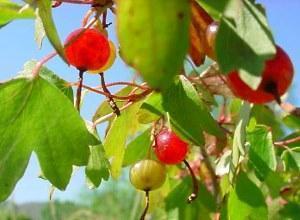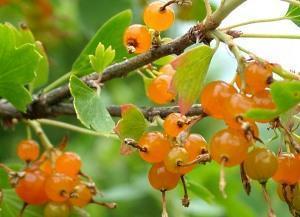Golden currant planting and care
 It seems that our gardeners know everything about currants! Most people in the garden or in the country have small plantations allocated for this culture, where they find a place bushes red
, black and white currant... These plants are quite easy to care for, easily multiply, their berries contain many trace elements and vitamins, especially in black currant. What can we say about the taste of these small berries and the variety of dishes that are prepared from them!
It seems that our gardeners know everything about currants! Most people in the garden or in the country have small plantations allocated for this culture, where they find a place bushes red
, black and white currant... These plants are quite easy to care for, easily multiply, their berries contain many trace elements and vitamins, especially in black currant. What can we say about the taste of these small berries and the variety of dishes that are prepared from them!
Most likely, many amateur gardeners will be surprised to see a photo of golden currants or almost familiar currant berries, but of an unusual color, on a bush where the leaves resemble gooseberry. And this is not a hybrid of currants and gooseberries, it is an independent species. Golden currant from the Gooseberry family, which includes about 150 other currant species. This berry culture is beginning to attract more and more attention - those who try it and learn the agricultural technology of growing golden currant become its active fans. Originally from Canada and the United States, it is now found in the northern regions of Russia, the Caucasus, the Far East and Europe.
Description of the species

Fruiting occurs in July; in August, on an unfertile bush, the leaves acquire a variegated color from orange to purple tones. During the flowering period (late May - early June), its cloud of numerous yellow flowers looks very decorative and exudes a fragrant aroma that attracts bees and bumblebees. This feature allows you to plant golden currants as decorative hedges that bring a considerable harvest of tasty and healthy berries. Vitamin C in this currant is several times less than in black currant, respectively, there is no that sourness, so it will be more to the taste of children and people with high acidity and stomach ulcers.
To set fruits, it is necessary to plant at least two different varieties of golden currants, since a single bush will only partially tie the fruits, and fruiting will be incomplete.
The plant is undemanding to soil and watering, it is drought-resistant, winter-hardy, gives an annual bountiful harvest of delicious berries and is not very susceptible to common diseases.
Reproduction of golden currants is possible in the following ways:
- sowing seeds;
- dividing the bush;
- cuttings with green and lignified branches;
- layering;
- annual shoots (like raspberries).
Growing golden currants is possible both in the usual bush form and in standard form. In the second case, the planted young seedling is formed from one strong shoot in the form of a tree with a trunk up to 70 cm, removing the rest of the young shoots. Gooseberries or other types of currants can be grafted onto a golden currant stem.
Planting and caring for golden currants
Golden currants are planted in early spring or autumn, but as far as possible from the onset of frost.The growing season of the plant lasts from mid-April to mid-September, and ideally, the planting of golden currants should be carried out either before or after the end of sap flow. But the seedlings sold in nurseries in pots with a closed root system can be planted at any time (from spring to autumn). Buy seedlings not dried out, with a good fibrous root system and developed 3-4 shoots.
 A place for golden currants is chosen well-lit, but partial shade will not hurt it. The bush will take root both on the plain and on the slopes of the site. The soil of the future plot for currants may be scanty and poor, this plant will survive on sand, on light clay, but it bears fruit best of all on fertile soil. Therefore, before planting, a pit of 50 * 60 cm is prepared, which is filled with compost or rotted manure with the addition of a glass of ash and superphosphate. According to the 2.4 * 1 m scheme, two-three-year-old seedlings are planted, deepening the root collar by 6-7 cm to accelerate the formation of adventitious roots and the growth of new shoots.
A place for golden currants is chosen well-lit, but partial shade will not hurt it. The bush will take root both on the plain and on the slopes of the site. The soil of the future plot for currants may be scanty and poor, this plant will survive on sand, on light clay, but it bears fruit best of all on fertile soil. Therefore, before planting, a pit of 50 * 60 cm is prepared, which is filled with compost or rotted manure with the addition of a glass of ash and superphosphate. According to the 2.4 * 1 m scheme, two-three-year-old seedlings are planted, deepening the root collar by 6-7 cm to accelerate the formation of adventitious roots and the growth of new shoots.
Simple care of golden currants includes digging the ground between rows once a year, fertilizing, pruning branches and watering. Cut off the branches that thicken the bush and prevent the penetration of the sun into its middle; sick, withered and over the age of three years, since with an increase in the age of the branch, the yield of berries on it decreases. Excess young growth is also cut out so as not to thicken the plantation. Pruning is carried out either before the buds swell, or after the end of leaf fall, in late autumn. Often these plants do not need to be watered (there will be enough rain), they are quite drought-resistant, only in the case of an unusual drought during the ripening period of berries, additional watering is required. This is one of their differences from common currant.
Here are some reasons why golden currants do not bear fruit:
- no pollinator bush;
- thickening of the bush or the presence of old branches;
- swampy heavy clay soil;
- fungal diseases (verticillosis).